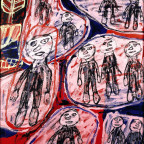Biography
In March 2012, Waddington Custot Galleries will be holding an exhibition of works from the last decade of Jean Dubuffet's life, some of which have never been exhibited before.
The exhibition has been organised with the help of the Dubuffet Foundation; it reveals the conclusive shift in style and technique that occurred during Dubuffet's final years, where he reverted to strong colours and basic imagery, depicting figures and spaces with no identifying features. Works on display include those from: Lieux abrégés (Abriged Places), Partitions (Partitions), Psycho-sites (Psycho-sites) and Sites aléatoires (Random sites).
Dubuffet was one of the most creative artists of the twentieth century, using a range of different mediums such as butterfly wings, sponges, polyurethane paint, polystyrene and volcanic lava. Throughout his career he created massive sculptures and architectural projects and used thick oil and acrylic paint to produce matter paintings. His innovative use of media and research into 'Art Brut' have inspired several artists that followed him.
This exhibition will feature one of Dubuffet's collaged paintings from the Théâtres de mémoire series, which has been lent by the Dubuffet Foundation: 'Site aux disjonctions (T330) 3 septembre 1977'. The Théâtres de mémoire were created from cut-up sections of the earlierLieux abrégés series from 1975, which Dubuffet had piled up on the floor. He also created new painted parts that referred to other locations and memories of past work. When it became difficult to move these sections around on the floor, Dubuffet used a large metal sheet on his studio wall to arrange the cut-up papers. He fixed magnets to the back of bits of collage so he could move them around on the metal, creating multiple images without a central focal point. The Théâtres de mémoireworks present an instant in our thoughts, where various images are juxtaposed, the past and the present becoming confused in our mind, as often happens when we have visual memories.
In the year from 1 February 1981, Dubuffet produced over 500 Psycho-sites. He worked on them hastily, concentrating on colour and featuring multiple figures with different proportions. Most of these paintings are highly colourful and show isolated figures in separate locations, denoted by blocks of different colours. These figures, like certain examples in the earlier paintings, had no individual facial identities. The Psycho-sites are full of intuition and vitality, foreshadowing the final two year's of Dubuffet's work, dominated by the Mires and Non-lieux; these final paintings have no human beings in them. It was the end.








